Climate and Environment
We report on work in assessing the impact of climate on human-elephant-conflict in response to requests from the Environment and Forest Conservation Division of the Mahaweli Authority of Sri Lanka. We have also characterized NDVI data sets and their links to climate. We hope to collaborate on the impacts of weather and climate on rare species which are sensitive to drought.
| Activity |
Objectives
|
Partners | Status | Next Steps |
| Evaluation of Climate and Habitat Interactions Affecting the Conservation and Management of
Asian Elephants in Southeast Sri Lanka (Funded by IRI, 2002-2003) |
Study the relationships between climate and elephant ecology in southeastern Sri Lanka, Develop geospatial
databases, Assess long-term scenarios of the responses of habitat and elephant ecology to seasonal climate
forecasts. |
Center for International Earth Science Information Networks (CIESIN), Center for Environmental
Research and Conservation (CERC), Mahaweli Authority of Sri Lanka (MASL). |
Geospatial Databases have been developed, climatological mapping has been undertaken,
statistical downscaling methodologies for downscaling from Global Climate Models have been developed, Project
Report completed by May 2004. |
Papers on downscaling to be submitted. Paper on climate-HEC relationship to be submitted. |
| Constructing Vegetation Climatologies (Funded by Earth Institute Internship and IRI) 2005. |
(a) Assess utility of NDVI indices (b) characterize climatologies of NDVI and relationship with rainfall and
temperature (c ) Assess NDVI relationship with ENSO |
International Research Institute for Climate and Society (IRI) and the Earth Institute at
Columbia University (EI) |
NDVI data sets archived in IRI data library for Sri Lanka, climatologies constructed, exploratory data
analysis shows utility, relationship between NDVI and climate indices documented. |
Relationship with ENSO to be completed. Paper to be published. |
|
|
|
|
|
|
Human-Elephant Conflict
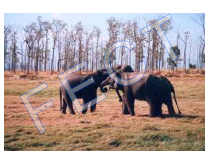 Global populations of the endangered Asian elephant (Elephas maximus) face an uncertain future due,
in part, to their populations having been relegated to small and relatively isolated pockets throughout their
historic
Global populations of the endangered Asian elephant (Elephas maximus) face an uncertain future due,
in part, to their populations having been relegated to small and relatively isolated pockets throughout their
historic
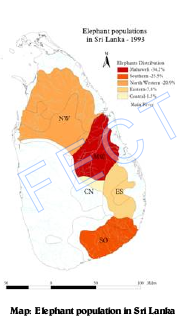
range in southern and southeastern Asia. In Sri Lanka, their numbers are thought to have dwindled from 8-20,000 to some 3,000-4,000 individuals. Resource competition, especially over two of the most important climatically influenced variables in the habitat, vegetation and water, is driving much of the conflict currently engulfing humans and elephants.
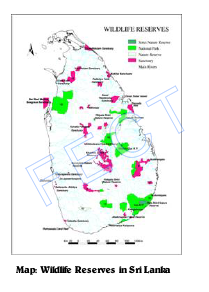
Understanding how interactions between climate and habitat can affect elephant ecology will be important for the long-term conservation and management of the species. As extreme conditions such as droughts repeat, wildlife becomes increasingly
vulnerable to climate variability and climate change. In our study, we have developed a database of fine-scale indices needed for wildlife management studies. These include a database of climatic parameters, hydrological parameters, vegetation indices, and drought indices.
This conflict is at the heart of environmental conflict, regulation and protection in rural areas. Climate affects water availability, vegetation, agricultural practices and irrigation. All of these factors could under conditions (such as drought, certain patterns of
irrigation or agriculture) lead to competition and conflict. The number of elephants killed each
year according to the Sri Lanka Department of Wildlife Conservation has been reported as:
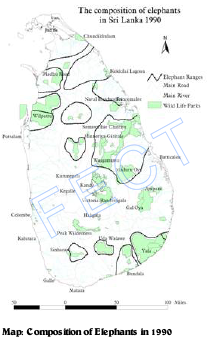
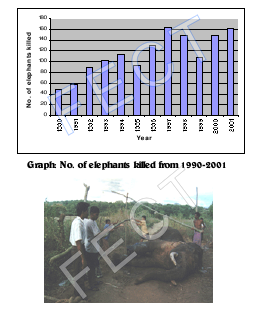
The sustainable coexistence of humans and elephants depends on:
- The maintenance of elephant population in numbers that ensure their genetic viability and resilience to occasional shocks
- The preservation of the habitat of elephants including the proper management of dual-use or non-conservation areas.
- The development of human societies in the peripheral areas so as to support their coexistence with the elephant populations and the minimization of human-elephant conflict.
- The management of longer term trends in demographics, environment, climate and land use.
Project Progress
We found that (a) the seasonality of elephant deaths peaked at the end of the dry season in April and August and declined in the wet seasons (b) both the long-term trends and inter-annual trends showed that there were greater elephant deaths during years which had dry periods (c ) that while climate was a significant factor in elephant deaths, other factors remain important too.
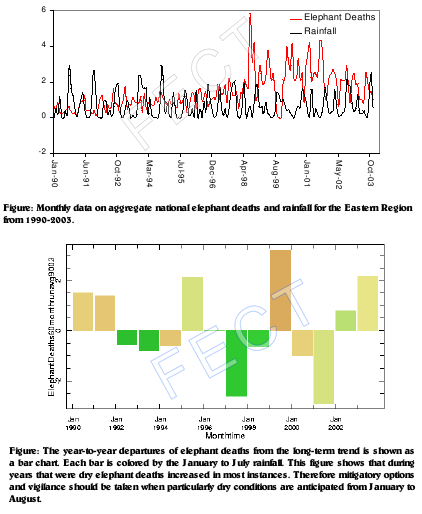
Remotely Sensed Vegetation (NDVI)
Remotely sensed vegetation indices have become available in the last 20 years providing additional data for analysis in such areas as human-elephant-conflict, agriculture and river basin management.We have characterized the NDVI (Normalized Difference Vegetation Index) data sets from 1981 to 2003.
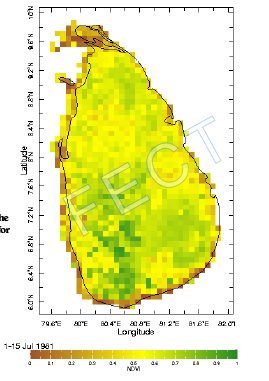
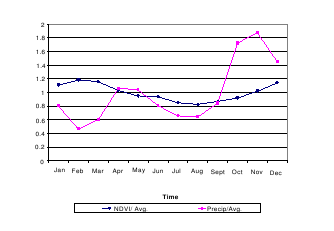
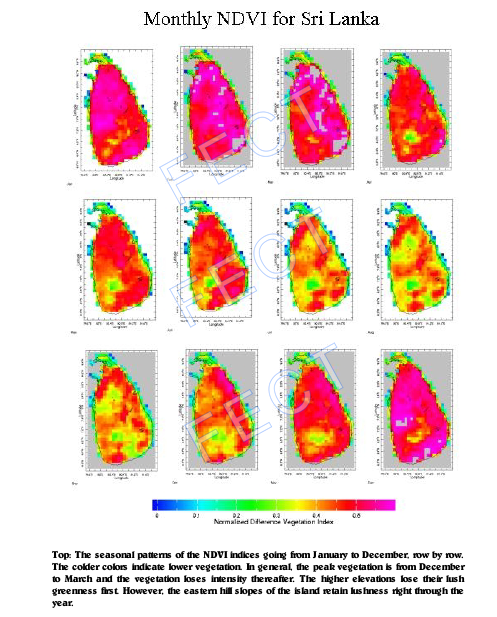
Outputs
Presentations
- December 2005: Lareef Zubair, Presentation to Prithiviraj Fernando and Centre for Research and Conservation,
Peradeniya, Sri Lanka.
- December 2004: Lareef Zubair, Presentation to the Environment and Forest Conservation Division of the Sri Lanka
Mahaweli Authority (in Sinhala), Polgolla.
- November 2004: Lareef Zubair Personal presentation to Director (P. Kariyawasam) and
Sociologist (Hendawitharana), Sri Lanka Department of Wildlife Conservation, Colombo 7.
- October 2004: Lareef Zubair, Climate and Endangered: Humans and Elephants in Sri Lanka, Open House, Lamont
Doherty Earth Observatory, Palisades.
- June 2004: Prithiviraj Fernando, Center for Environmental Conservation and Research, “Elephant Management
in Sri Lanka : A New Science Based Strategy”, IRI, Palisades.
Conference Proceedings
-
December 2004: Lareef Zubair, Joshua Qian, Neil Ward, Ousmane Ndiaye, Janaki Chandimala, Ruvini Perera, Vidhura Ralapanawe and Benno Blumenthal, Complementary Dynamical and Statistical Downscaling from a GCM: Maha rainfall over Sri Lanka, AGU Fall Meeting, San Francisco.
November 2004: with Benno Blumenthal, Janaki Chandimala, Ousmane Ndiaye, Ruvini Perera, Vidhura Ralapanawe and Neil Ward, Downscaling of Sri Lanka's Maha Rainfall from a GCM, International Conference on Sustainable Water Resources Management in the Changing Environment of the Monsoon Region, United Nations University, Colombo, Sri Lanka.
Reports
-
Lareef Zubair, Benno Blumenthal, Ousmane Ndiaye, Ruvini Perera, Neil Ward, Janaki Chandimala, Vidhura Ralapanawe, Upamala Tennakoon, M.R.A. Siraj, H. Manthrithillake, W.L. Hendawitharna, Evaluation of Climate and Habitat Interactions Affecting the conservation and management of Asian Elephants in Southeast Sri Lanka, Submitted to IRI, March 2005.
-
Stacey Hirsh, Characterization of NDVI data over Sri Lanka and its relationship with climate, in draft form, 2005.